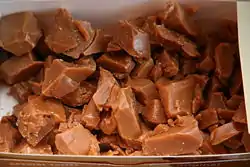Toffee
Toffee is a confection made by caramelizing sugar or molasses (creating inverted sugar) along with butter, and occasionally flour. The mixture is heated until its temperature reaches the hard crack stage of 149 to 154 °C (300 to 310 °F). While being prepared, toffee is sometimes mixed with nuts or raisins.
 | |
| Type | Confectionery |
|---|---|
| Course | Dessert |
| Main ingredients | Sugar or molasses, butter |
| Variations | English toffee, honeycomb toffee |

Variants and applications
A popular variant in the US is English toffee, which is a very buttery toffee often made with almonds. It is available in both chewy and hard versions. Heath bars are a brand of confection made with an English toffee core. Although named English toffee, it bears little resemblance to the wide range of confectionery known as toffee currently available in the United Kingdom. However, one can still find this product in the UK under the name "butter crunch". Conversely, in Italy they are known as "mou candies".[1]
Etymology
The origins of the word are unknown. Food writer Harold McGee claims it to be "from the Creole for a mixture of sugar and molasses", but which creole language is not specified.[2] The Oxford English Dictionary dates the first publication of the word to 1825 and identifies it as a variation of the word taffy (1817), both of which are first recorded as English dialectical words.[3][4]
See also
| Look up toffee in Wiktionary, the free dictionary. |
| Wikimedia Commons has media related to Toffee. |
References
- Hughes, Glyn Lloyd (2010). The Foods of England. Tomato. p. 265. ISBN 9780955694837.
- McGee, Harold (2004). On Food and Cooking: The Science and Lore of the Kitchen. Scribner. p. 650. ISBN 9780684800011.
- "toffee, n. and a.", Oxford English Dictionary Second Edition 1989
- "taffy1", Oxford English Dictionary Second Edition 1989
